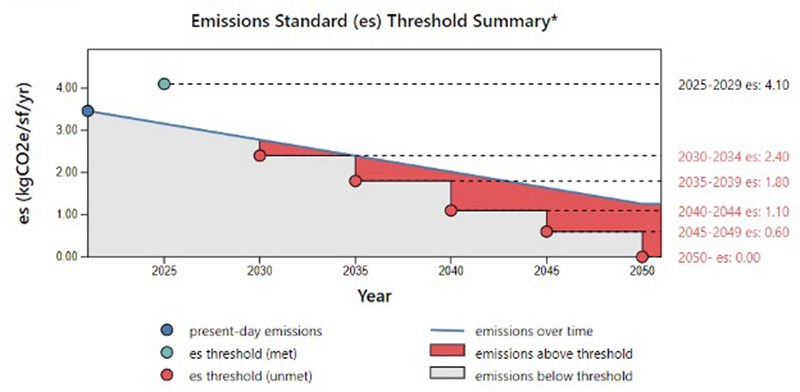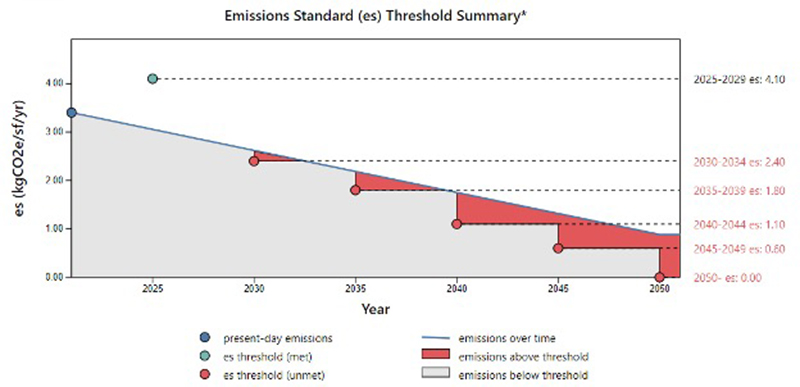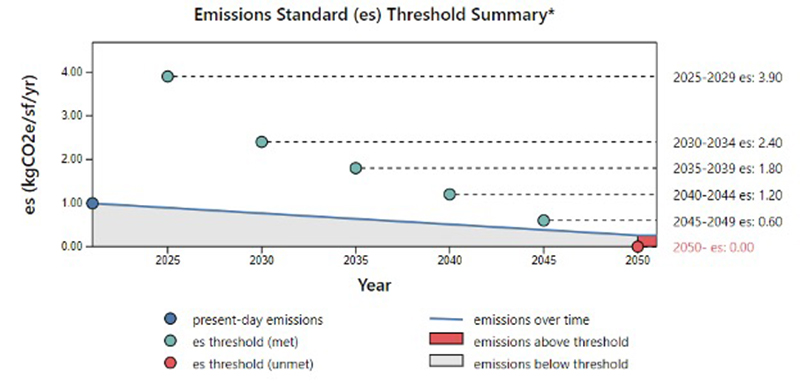Greener skylines ahead: BERDO 2.0 and LL 97 - Part III

This is the third article in a three-part series. To read Part II, please see the April 1st edition of NEREJ.
New York City’s Local Law 97 (LL97) and Boston’s Building Emissions Reduction and Disclosure Ordinance (BERDO 2.0) challenge existing large buildings to meet increasingly stringent carbon emissions standards. In this article we’ll show how AKF’s online calculators for LL97 (https://www.be-exchange.org/calculator/) and BERDO 2.0 (https://akf-berdo-calculator.herokuapp.com/) can be used to evaluate the effect of proposed carbon reduction measures (CRMs) on meeting carbon emissions standards.

New York City Challenges
Many decades-old buildings in NYC face significant decarbonization work to meet LL97. The following example is a 50-story commercial office building of approximately 2.5 million s/f built in 1970. Envelope thermal performance is poor; heating and cooling is provided by perimeter induction units served by air handling units utilizing chilled water and Con Edison steam. Image 1 is a screenshot from AKF’s LL97 Calculator. The tool brings in building size, type, and energy use to graph carbon emissions and resultant penalties ($268/yr/metric ton of carbon) in comparison to 2024-2029 and 2030-2034 allowances (2035+ values are not yet defined by NYC but are conservatively estimated). While business-as-usual facility operation meets 2024-2029 allowances, a 35% reduction in emissions is needed for 2030-2035 compliance. (see Image 1)
Based on an ASHRAE Level II energy audit and retro-commissioning (RCx), a number of recommended CRMs were identified including work to reduce steam losses, improvement of chilled water system controls, installation of variable frequency drives for pumps and fans, and improvement of ventilation controls to reduce emissions by 35% and eliminate penalties for the 2030-2034 period. Additional long-term measures including full electrification are being studied for complete decarbonization.

Meanwhile, in Boston
In addition to older buildings, even recently constructed projects can face challenges meeting BERDO 2.0, especially those with mixed electricity and fossil fuel use. The following example represents a 500,000 s/f, six-story multifamily project built for code compliance within the last few years. Residential units are conditioned with water source heat pumps served by an energy recovery ventilator with gas heating. Domestic hot water is heated with gas-fired condensing heaters. A screenshot from AKF’s BERDO 2.0 calculator is shown above. Red areas represent emissions above allowances where some combination of energy efficiency improvements, renewable energy purchase, or Alternative Compliance Payments (ACPs, $234/metric ton of CO2) is required. Compliance costs within the tool are conservatively estimated using ACPs even though power purchase agreements or approved Renewable Energy Certificates (RECs) may yield savings. Graphed carbon emissions drift downwards between now and 2050 due to Boston’s defined electric grid decarbonization (targeted 80% renewable energy by 2050) and are accounted for in the BERDO 2.0 Calculator. (See Image 2)

As shown, emissions comply with 2025 standards but exceed those of 2030 and beyond, with ACPs starting at $43,000/yr. As graphed in Image 3, switching to an all-electric system (replacing all gas-fired heating with heat pumps) enables the project to take full advantage of grid decarbonization, bringing the first ACP down to $24,000 in 2030. For further energy efficiency improvements, the project may investigate a rooftop solar array, geothermal system installation, or replacement of the central cooling towers and boilers with air-source electric heat pumps.( See Image 3)
Highly efficient all-electric designs can perform well against BERDO 2.0 standards. The following screenshot represents a 300,000 sf all-electric high school conditioned with a combination of air-cooled VRFs and ground source heat pumps. The addition of extensive roof and parking canopy PV arrays cut site electricity use by 50%. As shown below, the design achieves emissions well below standards, delaying and reducing ACPs to a single payment of $19,000 in 2050. (see Image 4)

Path Forward: New Construction
The Boston Planning and Development Agency (BPDA)’s Zero Net Carbon Building Zoning Initiative puts new construction projects on track to meet 2050 BERDO 2.0 standards (net zero carbon). While the final draft is not yet published, new construction projects are already being evaluated for approval according to draft standards. Meanwhile, New York City’s current building energy code combined with the natural gas ban (LL154, 2021) and 2040 electric grid decarbonization requirement put buildings on track for LL97’s 2030 targets and beyond.
Path Forward: Existing Building Strategies
Reducing carbon emissions from existing buildings is critical to achieving New York City and Boston climate goals. The rapidly approaching cost of carbon emissions has already shifted construction practices towards highly efficient all-electric systems while amplifying demand for renewable energy. AKF’s LL97 and BERDO 2.0 calculator tools can graphically define existing building performance and CRM impacts to inform cost effective compliance.
LL97 and BERDO 2.0 are groundbreaking policies that present many challenges for building owners, managers, developers, and design teams. Sports rivalries aside, building industry professionals in both cities can find new pride and motivation for climate action teamwork.
Roselin Osser, PE, BEMP, LEED AP is a senior engineer with AKF’s Energy + Performance team.
Nobis Group awards Robinson and Moreira STEM scholarships


Ask the Electrician: Is summer a prime time for commercial electrical maintenance?

The design-build advantage: Integrated interior design solutions - by Parker Snyder

The rise of incubators and co-working spaces: The latest in life sciences - by Matt Combs








